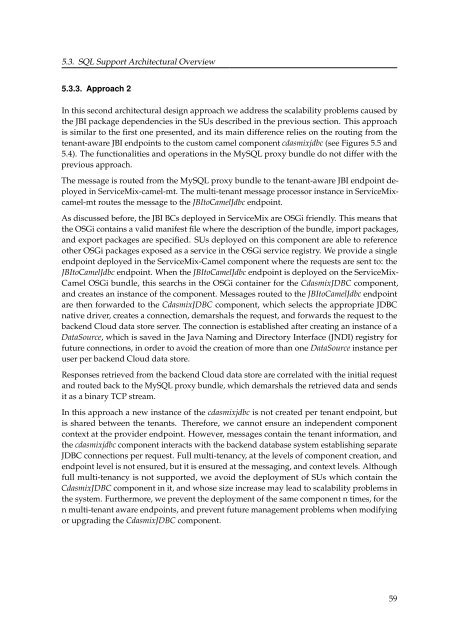Diploma Thesis Santiago Gómez Sáez - IAAS
Diploma Thesis Santiago Gómez Sáez - IAAS
Diploma Thesis Santiago Gómez Sáez - IAAS
You also want an ePaper? Increase the reach of your titles
YUMPU automatically turns print PDFs into web optimized ePapers that Google loves.
5.3. SQL Support Architectural Overview<br />
5.3.3. Approach 2<br />
In this second architectural design approach we address the scalability problems caused by<br />
the JBI package dependencies in the SUs described in the previous section. This approach<br />
is similar to the first one presented, and its main difference relies on the routing from the<br />
tenant-aware JBI endpoints to the custom camel component cdasmixjdbc (see Figures 5.5 and<br />
5.4). The functionalities and operations in the MySQL proxy bundle do not differ with the<br />
previous approach.<br />
The message is routed from the MySQL proxy bundle to the tenant-aware JBI endpoint deployed<br />
in ServiceMix-camel-mt. The multi-tenant message processor instance in ServiceMixcamel-mt<br />
routes the message to the JBItoCamelJdbc endpoint.<br />
As discussed before, the JBI BCs deployed in ServiceMix are OSGi friendly. This means that<br />
the OSGi contains a valid manifest file where the description of the bundle, import packages,<br />
and export packages are specified. SUs deployed on this component are able to reference<br />
other OSGi packages exposed as a service in the OSGi service registry. We provide a single<br />
endpoint deployed in the ServiceMix-Camel component where the requests are sent to: the<br />
JBItoCamelJdbc endpoint. When the JBItoCamelJdbc endpoint is deployed on the ServiceMix-<br />
Camel OSGi bundle, this searchs in the OSGi container for the CdasmixJDBC component,<br />
and creates an instance of the component. Messages routed to the JBItoCamelJdbc endpoint<br />
are then forwarded to the CdasmixJDBC component, which selects the appropriate JDBC<br />
native driver, creates a connection, demarshals the request, and forwards the request to the<br />
backend Cloud data store server. The connection is established after creating an instance of a<br />
DataSource, which is saved in the Java Naming and Directory Interface (JNDI) registry for<br />
future connections, in order to avoid the creation of more than one DataSource instance per<br />
user per backend Cloud data store.<br />
Responses retrieved from the backend Cloud data store are correlated with the initial request<br />
and routed back to the MySQL proxy bundle, which demarshals the retrieved data and sends<br />
it as a binary TCP stream.<br />
In this approach a new instance of the cdasmixjdbc is not created per tenant endpoint, but<br />
is shared between the tenants. Therefore, we cannot ensure an independent component<br />
context at the provider endpoint. However, messages contain the tenant information, and<br />
the cdasmixjdbc component interacts with the backend database system establishing separate<br />
JDBC connections per request. Full multi-tenancy, at the levels of component creation, and<br />
endpoint level is not ensured, but it is ensured at the messaging, and context levels. Although<br />
full multi-tenancy is not supported, we avoid the deployment of SUs which contain the<br />
CdasmixJDBC component in it, and whose size increase may lead to scalability problems in<br />
the system. Furthermore, we prevent the deployment of the same component n times, for the<br />
n multi-tenant aware endpoints, and prevent future management problems when modifying<br />
or upgrading the CdasmixJDBC component.<br />
59

















